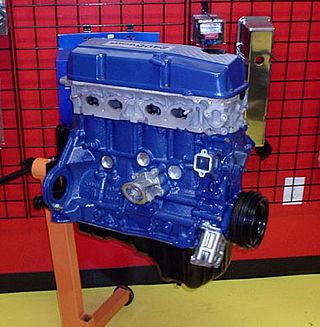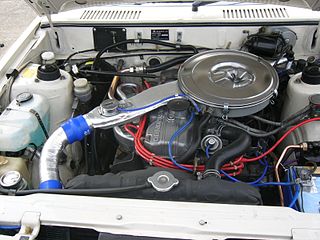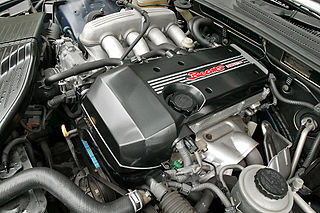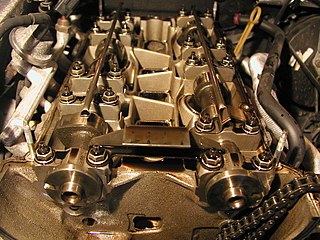Related Research Articles

The Ford Essex V6 engine is a 60° V6 engine built between 1966 and 1988 by the Ford Motor Company in the United Kingdom and until 2000 in South Africa although mostly in the Ford engine plant of Dagenham, Essex, which gave the engine its name. It is closely related to the Ford Essex V4 engine produced in displacements of 1.7 L and 2.0 L. Both engines share many parts since the Essex V6 was directly derived from the Essex V4; the 2.0 L Essex V4 and the 3.0 L Essex V6 in fact have exactly the same bore and stroke and share various components.

The Ford Cologne V6 is a series of 60° cast iron block V6 engines produced by the Ford Motor Company from 1962 and 2011 in displacements between 1.8 L; 110.6 cu in (1,812 cc) and 4.0 L; 244.6 cu in (4,009 cc). Originally, the Cologne V6 was installed in vehicles intended for Germany and Continental Europe, while the unrelated British Essex V6 was used in cars for the British market. Later, the Cologne V6 largely replaced the Essex V6 for British-market vehicles. These engines were also used in the United States, especially in compact trucks.

Mazda has a long history of building its own diesel engines, with the exception of a few units that were built under license.

The KA engines were a series of four-stroke inline-four gasoline piston engines manufactured by Nissan, which were offered in 2.0 and 2.4 L. The engines blocks were made of cast-iron, while the cylinder heads were made of aluminum.

The Mitsubishi Astron or 4G5/4D5 engine, is a series of straight-four internal combustion engines first built by Mitsubishi Motors in 1972. Engine displacement ranged from 1.8 to 2.6 litres, making it one of the largest four-cylinder engines of its time.

The Mitsubishi Sirius or 4G6/4D6 engine is the name of one of Mitsubishi Motors' four series of inline-four automobile engines, along with Astron, Orion, and Saturn.

The Lamborghini V10 is a ninety degree (90°) V10 petrol engine which was developed for the Lamborghini Gallardo automobile, first sold in 2003.

The Austin Motor Company A-series is a British small straight-4 automobile engine. Launched in 1951 with the Austin A30, production lasted until 2000 in the Mini. It used a cast-iron block and cylinder head, and a steel crankshaft with three main bearings. The camshaft ran in the cylinder block, driven by a single-row chain for most applications, and with tappets sliding in the block, accessible through pressed steel side covers for most applications, and with overhead valves operated through rockers. The cylinder blocks are not interchangeable between versions intended for conventional end-on mounted gearboxes and the 'in-sump' transaxle used on British Motor Corporation/British Leyland front wheel drive models such as the Mini. The cylinder head for the overhead-valve version of the A-series engine was designed by Harry Weslake – a cylinder head specialist famed for his involvement in SS (Jaguar) engines and several Formula One-title winning engines. Although a "clean sheet" design, the A-series owed much to established Austin engine design practise, resembling in general design and overall appearance a scaled-down version of the 1200cc overhead-valve engine first seen in the Austin A40 Devon which would form the basis of the later B-series engine.

The Toyota S Series engines are a family of straight-4 petrol or CNG engines with displacement from 1.8 L to 2.2 L produced by Toyota Motor Corporation from January 1980 to August 2007. The series has cast iron engine blocks and aluminium cylinder heads.
The L-series engine is an automotive diesel engine built by Powertrain Ltd, a sister company of MG Rover.

The Ford I4 DOHC engine is a cast iron block 4-cylinder inline internal combustion engine with twin overhead camshafts, produced by the Ford Motor Company at Dagenham Engine Plant. It was initially available as a 2.0 litre 8-valve version, and later in 2.0 and 2.3 litre 16-valve versions from 1989 to the end of production of the MK2 Ford Galaxy in 2006. It powered various Ford models during this time, but was most well known in the rear-wheel drive "Twin Cam" variants of the Ford Sierra and Ford Scorpio. Despite being built for the company's larger RWD models, Ford also employed the engine in the front-wheel drive Galaxy and the Escort RS 2000 16v.

The Volkswagen D24 engine is a 2.4-litre inline-six-cylinder (R6/I6), naturally aspirated diesel engine, formerly manufactured by Volkswagen Group from 1978 to 1995.

The Mercedes-Benz OM601 engine is a 4 cylinder diesel automobile engine that was manufactured by Mercedes-Benz.
The Rolls-RoyceC range was a series of in-line 4, 6 and 8 cylinder diesel engines used in small railway locomotives, construction vehicles, marine and similar applications. They were manufactured by the Rolls-Royce Oil Engine Division headed by William Arthur Robotham to 1963, initially at Derby and later at Shrewsbury, from the 1950s through to 1970s.
The Ferrari flat-12 engine family is a series of flat-12 DOHC petrol engines produced by Ferrari from 1964 to 1996. The first racing Ferrari flat-12, the Mauro Forghieri-designed Tipo 207, was introduced in the Ferrari 1512 F1 car in 1964. Later flat-12 racing engines were used in Ferrari Formula One and sports racing cars from 1968 until 1980, including the 212 E Montagna, 312 B series, 312 PB and 312 T series. The roadgoing flat-12 engines were introduced with the 365 GT4 BB and were produced in various versions until the end of F512M production in 1996.

The Volkswagen-Audi V8 engine family is a series of mechanically similar, gasoline-powered and diesel-powered, V-8, internal combustion piston engines, developed and produced by the Volkswagen Group, in partnership with Audi, since 1988. They have been used in various Volkswagen Group models, and by numerous Volkswagen-owned companies. The first spark-ignition gasoline V-8 engine configuration was used in the 1988 Audi V8 model; and the first compression-ignition diesel V8 engine configuration was used in the 1999 Audi A8 3.3 TDI Quattro. The V8 gasoline and diesel engines have been used in most Audi, Volkswagen, Porsche, Bentley, and Lamborghini models ever since. The larger-displacement diesel V8 engine configuration has also been used in various Scania commercial vehicles; such as in trucks, buses, and marine (boat) applications.
References
- 1 2 3 4 Weatherley, Brian (28 April 1984). "Ford's direct attack on the diesel doubters". Commercial Motor. pp. 27–29. Retrieved 30 June 2023.
- ↑ "Cold Start". Commercial Motor. 12 August 1977. Retrieved 30 June 2023.
- ↑ Bird, G.L. (1985). "The Ford 2.5 Litre High Speed Direct Injection Diesel Engine—Its Performance and Future Possibilities". SAE Transactions. 94: 454. JSTOR 44467593 . Retrieved 30 June 2023.